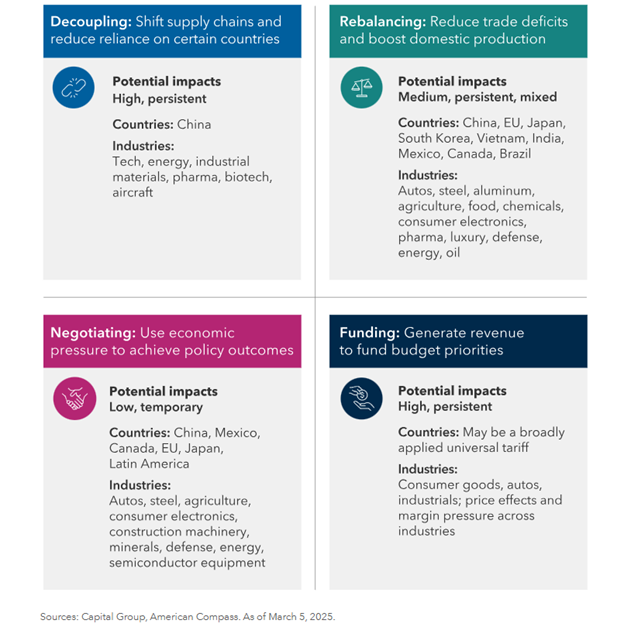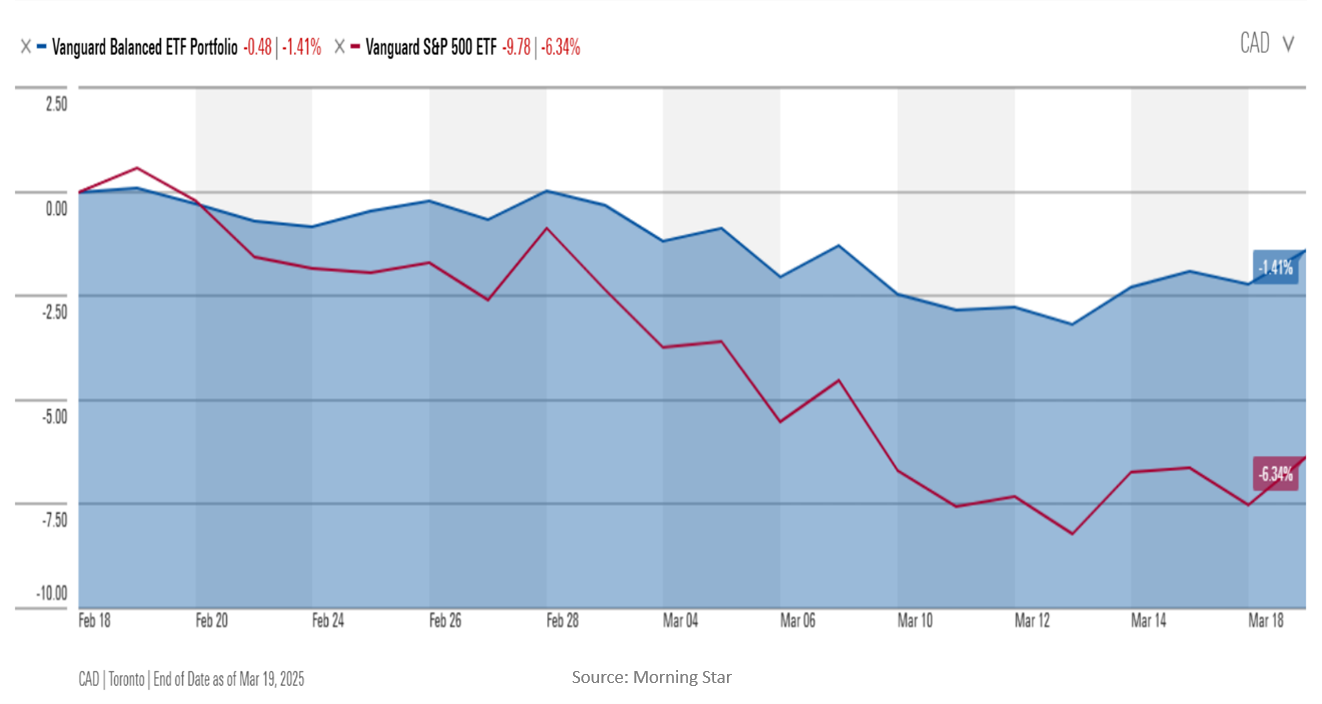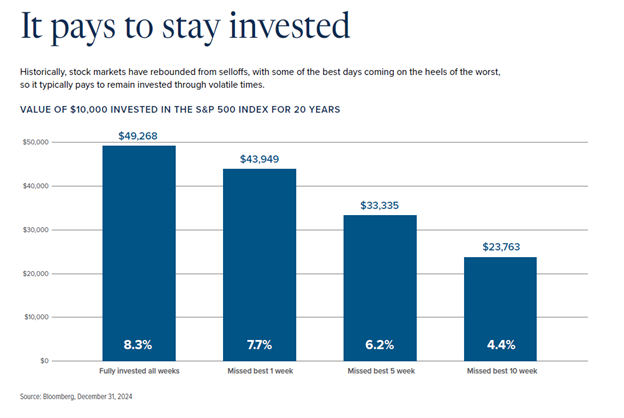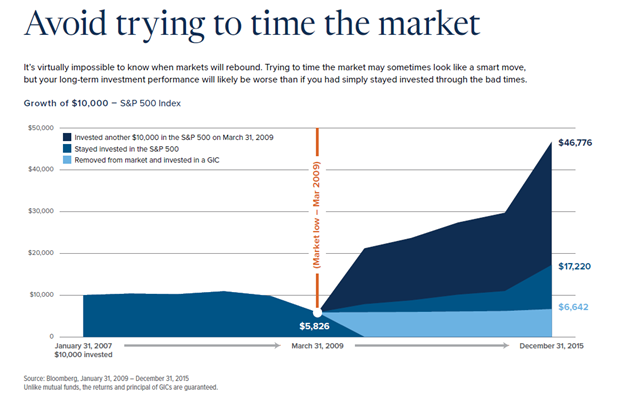[Winter 2025 GPS] US Tariffs
James Schofield - Mar 24, 2025
Barely three months into the year yet much has happened, perhaps more importantly the trade war with the US. In this GPS we delve into the implications for you portfolio.
Although we are hardly three months into the year, 2025 commenced with a blast. We could have covered numerous topics in this quarter’s GPS; but most investors are concerned about the trade war instigated by our southern neighbors and its implications for their portfolios, so that is where we will focus.
Typically, we do not start our newsletter with a conclusion, but in this case, we want to reinforce our key message:
1) Ignore the noise,
2) Stick to your long-term plan,
3) Avoid panic selling,
4) Invest in a well-diversified portfolio aligned to your risk tolerance and time horizon.
Understanding the New US Tariffs
Tariffs are taxes imposed on imported goods from foreign nations. They serve to safeguard domestic producers from international competition, among other objectives.
US President Donald Trump declared substantial tariffs on imports from Canada, Mexico, and China, citing apprehensions regarding illegal immigration and drug trafficking. A 25% blanket tariff will be imposed on all items imported from Canada. Canadian energy exports, including oil, natural gas, and hydroelectric electricity, will be granted a reduced tariff of 10%.
In addition, the US imposed 25% tariffs on all its world imports of steel and aluminum. Canada was affected as one of the largest exporters of these two metals to the US. For Canada, the 25% steel and aluminum tariffs will be added to the 25% blanket tariffs, meaning Canadian steel and aluminum will be tariffed at 50% total.
Finally, the US will impose reciprocal tariffs on all its trading partners. This means that if other countries place tariffs on American goods, the US will match those. If other countries raise or lower their tariffs, the US will do the same.
These reciprocal tariffs, which should begin on April 2, will affect Canada's dairy and lumber. Canada, China, and the EU announced retaliatory tariffs against the US.
The above developments should not be a surprise, as tariffs were a cornerstone of President Trump's 2024 election platform, integral to his overarching economic goal of fostering American self-sufficiency and safeguarding domestic industries.
Trump's first term saw a similar trade war, though the tariffs were much lower and only on selected products: washing machines, solar panels, steel, and aluminum.
What this Means for the Economy

It is hard to understand the effect of tariffs without knowing how long they will last. In other words, to determine their impact, we must first understand their motivation, as shown in the above chart.
Some economists have suggested that the US president is using tariffs as a negotiating tactic and expects an average effective tariff rate to settle at about 10%.
This is based on Trump's first term when, in May 2018, the US administration imposed tariffs of 25% on Canadian steel and 10% on Canadian aluminum for a year until the North American Free Trade Treaty was renegotiated.
Also, during US Secretary of Commerce Lutnick’s Senate hearing, he argued that there are two types of tariffs: those aimed at securing concessions from its trading partners, i.e., temporary, and those that will come once the full review of US trade policy is completed in early April, i.e., permanent.
It is almost impossible to know with certainty what the US administration's end game is, so we will assume that the announced tariffs will stay indefinitely at their current levels, which is the worst scenario.
Tariffs pour sand into the gears of commerce and trade, creating uncertainty. In general, businesses and equities markets dislike unpredictability. An investor assessing a company's value typically requires several years of insight into anticipated cash flows.
North American equity markets, especially the US market, experienced fast declines and high volatility. The S&P 500 dropped into correction territory (a 10% drop from the mid-February high).
For Canada, if prolonged, these tariffs increase the likelihood of a recession as the Canadian economy is already on a shaky footing. Canada has been and remains hindered by elevated household debt. Moreover, with interest rates significantly elevated compared to the previous decade, households will refinance their mortgages at higher rates, exacerbating financial strain as consumers allocate more of their discretionary spending to debt repayment instead of spending/stimulating economic growth. Tariffs exacerbate the vulnerabilities in Canada's already struggling economy.
The tariffs' effects are expected to increase unemployment and elevate commodity prices, presenting an additional burden to customers already contending with increased housing costs. Furthermore, this will occur when unemployment in Canada had been growing since the beginning of 2023.
It is important to note that the federal and provincial governments have support packages ready for businesses and individuals affected by tariffs. This means that the government's debt is expected to increase. Furthermore, the Bank of Canada will likely pause its fight against inflation and cut its key interest rate several times in 2025 to help spur economic growth.
On the other hand, the United States is in a better position to adapt to trade policy changes. The United States possesses advantages in terms of its size and affluent consumers, and the US economy is less dependent on global commerce than Canada. Nonetheless, increased tariffs will hinder economic activity and elevate import costs. Tariffs will impede growth when momentum appears to be diminishing. Before the imposition of tariffs, indications of an economic deceleration were already converging, specifically, declining retail sales and housing activity. Cuts in government spending hurt confidence, causing business losses and slowing work for companies with government contracts. While we think tariffs will make investments more unpredictable, we do not believe they will cause a major stock market crash (a drop of over 20%)
For the rest of the world, the tariffs imposed by the US, whether temporary or permanent, may accelerate a configuration of global trade that started with COVID-19 when the supply chain disruptions revealed the weaknesses associated with excessive dependence on foreign suppliers. Nations are reshoring or nearshoring industries vital to national security.
One important note about the rest of the world is related to China, which will likely be a net beneficiary. China has the largest population and the second largest economy and is strategically positioned to enhance trade partnerships as the US retreats. In contrast to prior cycles, China is now perceived as a viable investment market. China has established an aggressive GDP growth target of 5% for 2025, above the average prediction of approximately 4%. This objective will require a government stimulus to encourage investment, perhaps creating intriguing opportunities. They are not overly concerned about US tariffs because US exports make up less than 1% of China’s GDP.
Potential Silver Lining for Canada
The current trade war between the US and Canada is a crucial transition for Canada, a small economy significantly dependent on exports to the US. Now, Canada must maneuver through a new global landscape, which necessitates a shift towards self-sufficiency and trading partner diversification by enhancing exports to Asia and Europe.
Canada has a significant opportunity to redefine its role in the global economy through structural reforms focused on deregulation and enhancing the private sector. Canada can achieve energy independence by leveraging its abundant natural resources, including oil sands and hydroelectric power, while meeting the demand for clean technologies. Moreover, investing in critical minerals would establish Canada as a key supplier of sustainable technologies, such as electric vehicles. Establishing innovation hubs powered by economic energy can position Canada as a leader in artificial intelligence.
Ultimately, Canada may elevate its international standing, augment its bargaining power in trade negotiations, and fortify its resilience against shifting global economic conditions.
What This Means for Your Portfolio
As mentioned above, the US tariffs should not be a surprise; however, the breadth of the tariffs was somewhat surprising.
The managers of your portfolios have considered these tariffs since the last quarter of 2024 and have been taking a more defensive stance in response. They have reduced risk in their portfolios by trimming the elevated positions, buying more defensive stocks, and raising cash.
 Your portfolios are structured to withstand volatility through diversification and quality investments. Bonds, which serve as a buffer in market downturns, have regained effectiveness. For example, a typical 60/40 stock-bond portfolio is down ~1.4% over the last month, compared to the 6% drop in the S&P 500. The chart below shows the 1-month performance of a globally diversified portfolio with 40% bonds compared to the S&P 500.
Your portfolios are structured to withstand volatility through diversification and quality investments. Bonds, which serve as a buffer in market downturns, have regained effectiveness. For example, a typical 60/40 stock-bond portfolio is down ~1.4% over the last month, compared to the 6% drop in the S&P 500. The chart below shows the 1-month performance of a globally diversified portfolio with 40% bonds compared to the S&P 500.
We understand that there is a negative sentiment around the stock market with all the uncertainty of tariffs, and at times like this, some investors want to hit the sell button or try to make changes to their portfolios. We do not recommend this. Historically, panic selling has proven to be costly as shown below.

Making changes to your portfolio during volatility is one way of trying to time the market, but we know that market timing doesn't work. A lot of research shows how costly it is to miss the market's best days.

To summarize:
- Ignore the headlines and stay focused on your long-term plan.
- Avoid panic selling. Selling at a loss and missing the rebound is a costly mistake.
- Volatility is expected, but your diversified portfolio is built to manage it.
It's Tax Season, But:
The government’s planned increase in the capital gains inclusion rate was initially set for June 25, 2024, but political delays have pushed it to January 1, 2026. As a result, the Canada Revenue Agency (CRA) advises taxpayers to delay filing 2024 returns if reporting capital gains. To accommodate the changes, the CRA has extended the deadline for affected taxpayers to June 2, 2025.
We covered these updates in our February 28 email. Please let us know if you have any questions about tax slips or returns.
We look forward to seeing you all in the office, but in the meantime, as always, please let us know if there is anything we can do to help or explain things further.
Thanks for reading, and all the Best!
James, Ahmed, and Steve
Assante Capital Management Ltd. 613-729-3222
James Schofield, B.A., CFP®, CIM | Senior Financial Planning Advisor | |Ext. 228| jschofield@assante.com
Ahmed El-Shaboury PhD, CFP®, CIM, CLU | Associate Financial Advisor |Ext. 236| email: aelshaboury@assante.com
Steven Hughes, CFP®, CLU, CIM | Associate Financial Advisor |Ext. 229| email: steven.hughes@assante.com